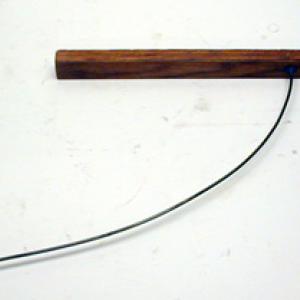College of Liberal Arts & Sciences
1J20.30 - Sky Hook
This system will appear to balance on the edge of a table or a finger. The reason is because the brass weight must move upward in any direction for the system to fall off a table or a finger tip.
- Terrence P. Toepker, "More Belt Hook Mechanics", TPT, Vol. 42, # 2, Feb. 2004, p. 70.
- Terrence P. Toepker, "A Center of Gravity Demonstration", TPT, Vol. 15, # 4. Apr. 1977, p. 241, reprinted in TPT, Vol. 41, # 9, Dec. 2003, pg. 549.
- Ray Turner, "100 Years of Physics and Toys: Balancing Toys", TPT, Vol. 30, # 9, p. 542, Dec. 1992.
- Scott Welty and Norbert Zarumba, "The Pendulum and the Apple", TPT, Vol. 21, # 6, Sept. 1983, p. 340.
- James Watson, Jr., Nancy T. Watson, "Pocketbook Science", TPT, Vol. 20, # 4, Apr. 1982, p. 235.
- Vincent Buckwash, "Ways to Demonstrate Center of Gravity", TPT, Vol. 14, # 1, January 1976, p. 39.
- Terrence P. Toepker, " More Center of Gravity", TPT, Vol. 14, # 8, , Nov. 1976, p. 499.
- Mp- 3, 4: Freier and Anderson, A Demonstration Handbook for Physics.
- M- 470: "Hammer on Hinged Board & Loop", DICK and RAE Physics Demo Notebook.
- M- 33: Richard Manliffe Sutton, Demonstration Experiments in Physics.
- Vincent Buckwash, "Ways to Demonstrate Center of Gravity", A Potpourri of Physics Teaching Ideas, Jan 1976, p. 39.
- Carson I. A. Ritchie, "The Balancing Horse", Making Scientific Toys, p. 92.
- "Decorative Toys and Boxes Made at Home", The Boy Mechanic Makes Toys, p. 199.
- Cy Tymoney, "Sneaky Balancer III", Sneakiest Uses for Everyday Things, p. 15 .
- Brown, "A Gravity Trick", 333 More Science Tricks and Experiments, p. 48- 49.
- Janice VanCleave, "Over the Edge", 200 Gooey, Slippery, Slimy, Weird & Funny Experiments, p. 95.
Disclaimer: These demonstrations are provided only for illustrative use by persons affiliated with The University of Iowa and only under the direction of a trained instructor or physicist. The University of Iowa is not responsible for demonstrations performed by those using their own equipment or who choose to use this reference material for their own purpose. The demonstrations included here are within the public domain and can be found in materials contained in libraries, bookstores, and through electronic sources. Performing all or any portion of any of these demonstrations, with or without revisions not depicted here entails inherent risks. These risks include, without limitation, bodily injury (and possibly death), including risks to health that may be temporary or permanent and that may exacerbate a pre-existing medical condition; and property loss or damage. Anyone performing any part of these demonstrations, even with revisions, knowingly and voluntarily assumes all risks associated with them.
